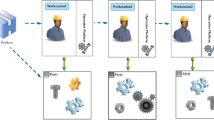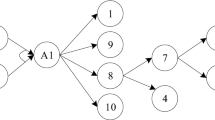Abstract
Disassembly is the first step in product recycling and remanufacturing. When disassembling large quantities of products, the disassembly efficiency is crucial for enterprises. Thus, disassembly line is the best choice for automated disassembly of disposal products. Disassembling products, especially complex structure of products, consume a lot of resources and energy and produce large amounts of carbon emissions. So, it is essential for disassembly line to work efficiently and environmentally. In this paper, the hybrid graph is proposed to express the direct and indirect constraint relationship among components. Then, the mathematical model of carbon emission is built by quantifying the carbon emissions in the process of product disassembly. Taking into account the basic disassembly time, direction change time and tool change time, the mathematical model of high efficiency is presented for optimizing disassembly time. Additionally, based on the traditional multi-objective disassembly line balancing problem (DLBP), a novel multi-objective optimization model of the DLBP with shortest disassembly time and minimum carbon emissions is proposed for improving disassembly efficiency and reducing the carbon emissions in the process of disassembly. Furthermore, genetic algorithm is presented for optimizing the disassembly sequence. Finally, an automobile engine is given as an example to confirm the practicality of the proposed model in solving the DLBP.











Similar content being viewed by others
References
Ministry of Commerce of the People's Republic of China. (2017). Report of China renewable resource recycling industry development. Resource Recycling, 5, 16–25.
Lee, C. M., Woo, W. S., & Roh, Y. H. (2017). Remanufacturing: Trends and Issues. International Journal of Precision Engineering and Manufacturing-Green Technology, 4(1), 113–125.
Clegg, A. J., & Williams, D. J. (2019). The strategic and competitive implication of recycling and design for disassembly in electronics industry. IEEE International Symposium on Electronics and the Environment, 1994(5), 6–12.
Dillon, P. S. (1994). Salvageability by design. IEEE Spectrum, 39(8), 18–21.
Mcgovern, S. M., & Gupta, S. M. (2006). Ant colony optimization for disassembly sequencing with multiple objectives. International Journal of Advanced Manufacturing Technology, 30(5-6), 481–496.
Seitz, M. A. (2007). A critical assessment of motives for product recovery: the case of engine remanufacturing. Journal of Cleaner Production, 15(11), 1147–1157.
Matsumoto, M., Yang, S. S., Martinsen, K., & Kainuma, Y. (2016). Trends and research challenges in remanufacturing. International Journal of Precision Engineering and Manufacturing-Green Technology, 3(1), 129–142.
McGovern, S. M., & Gupta, S. M. (2011). The disassembly line: Balancing and modeling. Production Planning & Control, 22(7), 723–724.
Kalayci, C. B., & Gupta, S. M. (2014). A tabu search algorithm for balancing a sequence-dependent disassembly line. Production Planning & Control, 25(2), 149–160.
Gungor, A., & Gupta, S. M. (2001). A solution approach to the disassembly line problem in the presence of task failures. International Journal of Production Research, 39(7), 1427–1467.
McGovern, S. M., Gupta, S. M., & Kamarthi, S. V. (2003). Solving disassembly sequence planning problems using combinatorial optimization. Proceedings of the 2003 Northeast Decision Sciences Institute Conference, 2003, (pp. 178–180).
McGovern, S. M., & Gupta, S. M. (2007). A balancing method and genetic algorithm for disassembly line balancing. European Journal of Operational Research, 179(3), 692–708.
Ding, L.P., Chen, W.L., Tan, J.R., & Feng, Y.X. (2010). Multi-objective disassembly line balancing via modified ant colony optimization algorithm. IEEE Fifth International Conference on Bio-Inspired Computing: Theories and Applications, 2010 (pp. 426–430).
Ding, L. P., Feng, Y. X., Tan, J. R., & Gao, Y. C. (2010). A new multi-objective ant colony algorithm for solving the disassembly line balancing problem. International Journal of Advanced Manufacturing Technology, 48(5-8), 761–771.
Zhang, Z. Q., Wang, K. P., Zhu, L. X., & Wang, L. (2017). A pareto improved artificial fish swarm algorithm for solving a multi-objective fuzzy disassembly line balancing Problem. Expert Systems with Applications, 86, 18–23.
Li, W., Bai, H., Yin, J., et al. (2016). Life cycle assessment of end-of-life vehicle recycling processes in China—take Corolla taxis for example. Journal of Cleaner Production, 40(2016), 176–187.
Su, J. C. P., Chu, C. H., & Wang, Y. T. (2012). A decision support system to estimate the carbon emission and cost of product designs. International Journal of Precision Engineering and Manufacturing, 13(7), 1037–1045.
Liu, T., Huang, H. H., et al. (2011). Product life cycle energy consumption analysis method considering remanufacturing. Applied Mechanics & Materials, 55–57(2011), 729–736.
Gungor, A., & Gupta, S. M. (1999). Issues in environmentally conscious manufacturing and product recovery: A survey. Computers & Industrial Engineering, 36(4), 811–853.
Iigin, M. A., & Gupta, S. M. (2010). Environmentally conscious manufacturing and product recovery (ECMPRO): A review of the state of the art. Journal of Environment Management, 91(3), 563–591.
Mete, S., & Cil, Z. (2016). A resource constrained disassembly line balancing problem. IFAC-Papers Online, 49(12), 921–925.
Seo, K. K., Park, J. H., & Jang, D. S. (2001). Optimal disassembly sequence using genetic algorithms considering economic and environmental aspects. International Journal of Advanced Manufacturing Technology, 18(5), 371–380.
Wang, Y. L., Li, F. Y., & Chen, J. et al. (2009) Hybrid graph disassembly model and sequence planning for product maintenance. Technology and Innovation Conference, 2006. ITIC 2006. International, 2006 (pp. 515–519).
National Development and Reform Commission to Deal with the Department of Climate Change. Chinese Regional Power Grid Baseline Emissions Factor in 2015 [EB/OL]. http://cdm.ccchina.org.cn/archiver/cdmcn/UpFile/Files/Default/20160606120244478242.pdf. Accessed 18 July 2019.
Zhou, D., Lan, S., Gao, X., Huang, H. H., et al. (2018). Nondestructive surface threshold definition for remanufacturing disassembly of interference fit. International Journal of Precision Engineering and Manufacturing, 19(11), 1735–1743.
Li, F. X., Zhu, C., Cao, L., et al. (2013). Research on the calculation method of carbon emissions of coal industry and low carbon operation mode. Coal Quality Technology, 2013(6), 64–68.
Yang, S. N., Qing, M. S., & Weng, Q. (2015). Organizational effectiveness evaluation model for construction projects based on fuzzy-analytic hierarchy processes. Journal of Tsinghua University (Science and Technology), 55(6), 616–623.
Bao, W. S., & Liu, X. G. (2007). Structure optimization algorithm of RBF neural networks based on adaptive genetic algorithm. Journal of Shandong Normal University (Natural Science), 22(3), 37–39.
Li, Y. (2015). Automobile engine structure and disassembly. China: Beijing Institute of Technology Press Beijing.
Funding
This work is financially supported by the National Natural Science Foundation of China (Grant No. 51575152).
Author information
Authors and Affiliations
Corresponding author
Additional information
Publisher's Note
Springer Nature remains neutral with regard to jurisdictional claims in published maps and institutional affiliations.
Rights and permissions
About this article
Cite this article
Zhang, L., Zhao, X., Ke, Q. et al. Disassembly Line Balancing Optimization Method for High Efficiency and Low Carbon Emission. Int. J. of Precis. Eng. and Manuf.-Green Tech. 8, 233–247 (2021). https://doi.org/10.1007/s40684-019-00140-2
Received:
Revised:
Accepted:
Published:
Issue Date:
DOI: https://doi.org/10.1007/s40684-019-00140-2




